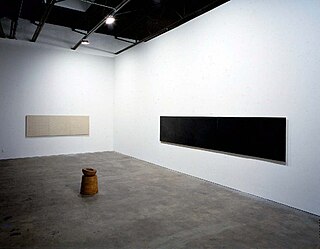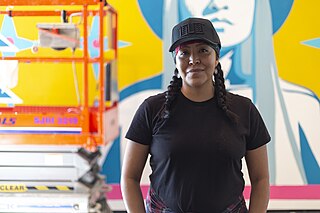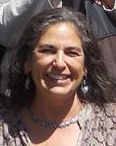Related Research Articles

Taos is a town in Taos County in the north-central region of New Mexico in the Sangre de Cristo Mountains. Initially founded in 1615, it was intermittently occupied until its formal establishment in 1795 by Nuevo México Governor Fernando Chacón to act as fortified plaza and trading outpost for the neighboring Native American Taos Pueblo and Hispano communities, including Ranchos de Taos, Cañon, Taos Canyon, Ranchitos, El Prado, and Arroyo Seco. The town was incorporated in 1934. As of the 2010 census, its population was 5,716.

The Taos art colony was an art colony founded in Taos, New Mexico, by artists attracted by the culture of the Taos Pueblo and northern New Mexico. The history of Hispanic craftsmanship in furniture, tin work, and other mediums also played a role in creating a multicultural tradition of art in the area.

Agnes Bernice Martin, was an American abstract painter. Her work has been defined as an "essay in discretion on inward-ness and silence". Although she is often considered or referred to as a minimalist, Martin considered herself an abstract expressionist and was one of the leading practitioners of Abstract Expressionism in the 20th century. She was awarded a National Medal of Arts from the National Endowment for the Arts in 1998. She was elected to the Royal Canadian Academy of Arts in 2004.
William Victor Higgins was an American painter and teacher, born in Shelbyville, Indiana. At the age of fifteen, he moved to Chicago, where he studied at the Art Institute in Chicago and at the Chicago Academy of Fine Arts. In Paris he was a pupil of Robert Henri, René Menard and Lucien Simon, and when he was in Munich he studied with Hans von Hayek. He was an associate of the National Academy of Design. Higgins moved to Taos, New Mexico in 1913 and joined the Taos Society of Artists in 1917. In 1923 he was on the founding board of the Harwood Foundation with Elizabeth (Lucy) Harwood and Bert Phillips.

Gloria Graham is an American artist based in New Mexico. Her work includes sculpture, painting, and photography.

Hon. Dorothy Eugénie Brett was an Anglo-American painter, remembered as much for her social life as for her art. Born into an aristocratic British family, she lived a sheltered early life. During her student years at the Slade School of Art, she associated with Dora Carrington, Barbara Hiles and the Bloomsbury group. Among the people she met was novelist D.H. Lawrence, and it was at his invitation that she moved to Taos, New Mexico in 1924. She remained there for the rest of her life, becoming an American citizen in 1938.

The Millicent Rogers Museum is an art museum in Taos, New Mexico, founded in 1956 by the family of Millicent Rogers. Initially the artworks were from the multi-cultural collections of Millicent Rogers and her mother, Mary B. Rogers, who donated many of the first pieces of Taos Pueblo art. In the 1980s, the museum was the first cultural organization in New Mexico to offer a comprehensive collection of Hispanic art.

Harwood Foundation is a non-profit organization in Taos, New Mexico that was listed as a National Register of Historic Places in 1976. For seventy-five years, serving as a public library, museum, auditorium, classrooms and meeting rooms, the Harwood was at the heart of the social and artistic life of Taos, New Mexico.
William Davis is an American photographer based in Taos, New Mexico. Originally from High Point, North Carolina, Davis moved to Taos, New Mexico in 1969. He creates work inspired by the area. In 1979, Davis's work was published in a collaborative effort with the writer, John Nichols in a photo-memoir “If Mountains Die”. The book helped to increase awareness of Davis' work, and in the following years his work was included in the collection of the Harwood Museum in Taos.

Blanche Chloe Grant (1874–1948) was an American artist, magazine illustrator and wrter. She is remembered as a muralist as well as a painter of Native Americans. Born in Leavenworth, Kansas, she studied at Vassar College, at the School of the Museum of Fine Arts in Boston, the Pennsylvania Academy of Fine Arts, and the Art Student's League. She studied with Howard Pyle and in 1911, along with Ethel Leach and Olive Rush, she was living in Pyle's studio, when he died on a trip to Italy. By 1914 she was established as a magazine illustrator and landscape painter.
Eva Mirabal, also known as Eah-Ha-Wa (1920–1968) was a Native American painter, muralist, illustrator, and cartoonist from Taos Pueblo, New Mexico. Her primary medium was gouache, a type of watercolor.
Alice Geneva "Gene" Kloss was an American artist known today primarily for her many prints of the Western landscape and ceremonies of the Pueblo people she drew entirely from memory.
Luis E. Tapia is a self-taught artist living in New Mexico best known for his innovative wood carvings that blend the local bulto tradition with contemporary culture and co-founding La Cofradia de Artes y Artesanos Hispanicos with artist Frederico Vigil. He has also done major restoration work at churches, including the San Francisco de Asis Mission Church in Ranchos de Taos. Tapia's awards include an NEA grant in 1980 and a New Mexico Governor's Awards for Excellence in the Arts in 1996.
Oli Sihvonen was a post-World War II American artist known for hard-edge abstract paintings. Sihvonen's style was greatly influenced by Josef Albers who taught him color theory and Bauhaus aesthetics at Black Mountain College in the 1940s. Sihvonen was also influenced by Russian Constructivism, Piet Mondrian, and Pierre Matisse. His work has been linked to Abstract Expressionism, Minimalism, Hard-Edge and Op-Art.
Bernadette Vigil is an American artist and illustrator whose work has been exhibited in museums and galleries nationally and abroad. She has produced permanent public artworks in the form of fresco murals for the cities of Santa Fe and Albuquerque, New Mexico. She has been commissioned to create religious frescoes in churches in New Mexico, and has been called a "master of the art of buon fresco" in the Santos Tradition. She has authored a book on Toltec spirituality, Mastery of Awareness: Living the Agreements. In 2002 it was published in Spanish as El Dominio de la Conciencia, and in 2005 it was published in German as Das Geheimnis der vier Versprechen.
Olivia Romo is an American poet, spoken word artist and water rights activist from Taos, New Mexico. Romo lives in Pojoaque, and works in Santa Fe, New Mexico.

Helene Valeska Billing Wurlitzer (1874–1963) was notable for her philanthropy in the arts in both Ohio and New Mexico. Helene was born in Salt Lake City to German immigrant Gustav Billing (1840-1890) and Henriette Schneider Billing (1849-1939), a Cincinnati physician’s daughter. Helene’s parents were in Utah establishing a mining smelter funded by Ohio investors. She was the first of two children; her sister being born in 1888.
Pola Lopez is a painter and muralist known for her abstract, southwestern-inspired artworks.

Lynnette Haozous a Native American painter, printmaker, jeweler, writer, and actor. She is an enrolled member of the San Carlos Apache Tribe and of Chiricahua Apache, Navajo, and Taos Pueblo ancestry. Haozous works in acrylics, watercolors, spray paint, jewelry, screen-printing, writing, and acting on stage and in film. She is known for her murals and uses a blend of art and advocacy to bring attention to social conditions and injustices.

Maye Torres is an American artist who specializes in large-scale drawings and sculptures. Raised in New Mexico and Latin America, her work is influenced by the arts, cultures and spiritual beliefs of those areas.
References
- ↑ de Lallier, Alexandra (1985). "Rio Grande Textiles". The Clarion (Winter): 48–49.
- ↑ Robbins, Catherine C. (July 18, 1982). "SHOPPER'S WORLD; WEAVERS OF THE RIO GRANDE". The New York Times. Retrieved 4 July 2021.
- ↑ McIntyre, Kellen. "RIO GRANDE BLANKETS Late 19th Century Textiles in Transition". Adobe Gallery. Retrieved 8 March 2021.
- 1 2 "The Barrio Murals". National Museum of Mexican Art. Retrieved 9 March 2021.
- 1 2 3 4 5 6 Clark, Virginia L. "Labor of love, Juanita Jaramillo Lavadie: educator, artist, acequiera and historian". The Taos News. Retrieved 2021-03-06.
- 1 2 3 4 5 CĂłrdova, Kathy (November 6, 2018). "Know Your Neighbor: Juanita J. Lavadie". Taos News. Retrieved 4 July 2021.
- ↑ Durán, Ray Hernández; Vásquez, Irene (2019). "Artistas del Pueblo: In Conversation with the History of New Mexican Chicanx Art". HEMISPHERE Visual Cultures of the Americas. XII: 80. Retrieved 8 March 2021.
- 1 2 Kramer, Ariana. "Vision of life and death". Taos News. Retrieved 9 March 2021.
- 1 2 "National Endowment for the Arts: 1980 Annual Report" (PDF). USA.gov. Retrieved 8 March 2021.
- ↑ Lewthwaite, Stephanie (2015). A Contested Art: Modernism and Mestizaje in New Mexico. University of Oklahoma Press. p. 108. ISBN 978-0806148649 . Retrieved 8 March 2021.
- ↑ Mercedes Everett, Ethel (2019). "La Cofradía de Artes y Artesanos Hispánicos: Redefining Tradition in the New Mexican Art Market". The City College of New York. Retrieved 13 March 2021.
- ↑ Archuleta, Margaret (1991). Chispas! Cultural Warriors of New Mexico. Heard Museum. p. 2. Retrieved 8 March 2021.
- ↑ "Women by Women: A Historic Exhibition of Leading Hispana Artists Portraying the Image of Women" (PDF). Galeria de la Raze. 1985.
- ↑ "JUANITA J. LAVADIE, OLIVIA ROMO & DAVID GARCÍA SPINNING WITH WATER WISDOM". Paseo Project. Retrieved 15 March 2021.
- ↑ "Collections :: The Harwood Museum of Art :: Taos :: University of New Mexico". collections.harwoodmuseum.org. Retrieved 2021-03-08.
- ↑ "Placemat: Juanita Jaramillo Lavadie". National Museum of the American Indian, Smithsonian Institution. Retrieved 13 March 2021.